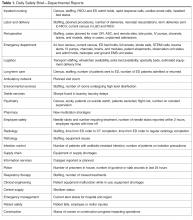It was determined that a leader and 2 facilitators would be assigned to each call. The role of the DSB leader is to trigger individual department report outs and to ensure follow-up on unresolved safety issues from the previous DSB. Leaders are recruited by senior leadership and need to be familiar with the effects that issues can have across the health care system. Leaders need to be able to ask pertinent questions, have the credibility to raise concerns, and have access to senior administration when they need to bypass usual administrative channels.
The role of the facilitators, who are all members of the Center for Quality, is to connect to the conference bridge line, to keep the DSB leader on task, and to record all departmental data and pertinent details of the DSB. The facilitators maintain the daily DSB document, which outlines the order in which departments are called to report and identifies for the leader any open items identified in the previous day’s DSB.
The team developed educational materials and began coaching the departments in February 2013 (See timeline, Figure 1 ). Our hospital began an institution-wide initiation of TeamSTEPPS (Team Strategies and Tools to Enhance Performance and Patient Safety) [5] around the same time and we have found that to be a fortuitous coincidence. Promotion of safety and quality are guiding principles of TeamStepps, an evidence-based teamwork system aimed at optimizing patient care by improving communication and teamwork skills among all health care professionals. It includes a comprehensive set of ready-to-use materials and a training curriculum to successfully integrate teamwork principles into a variety of settings. The TeamSTEPPS framework comprises 4 areas: Leadership, Situational Monitoring, Mutual Support, and Communication. As our DSB was developed, it became clear that components of TeamStepps were integral to successful communication of the new program across departments and disciplines. All departments participating in our DSB began to utilize tools from the 4 TeamSTEPPS domains.

